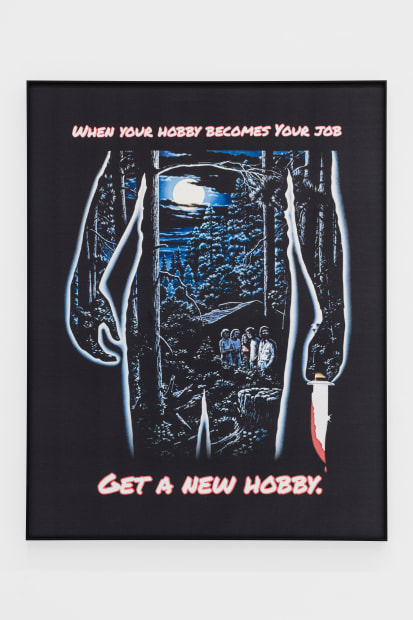-
Richie Culver
Leisure & Tourism -
Born in Hull in the North of England into a working-class family, Culver was not exposed to art growing up and left school with no qualifications to work in a factory making caravans. His practice encompasses diverse elements that range from painting, sculpture and photography to digital performance. Within this, Culver’s work is largely biographical wrestling with aspects of social class, contemporary masculinity and the digital lens through which we live our lives. A large proportion of Culver’s practice lies in his antagonistic relationship with technology, the ultimate impermanence of social media and the effects upon human interaction and linguistics, alongside personal and cultural memory. In this regard, much of the material for Culver’s works are formed from images collected on his phone including mundane mobile photography, google translate and notes apps screenshots containing excerpts of conversations, phrases and information. These screenshots are then blown up and printed on canvas, ultimately forming a visual record of an inner monologue that is fractured and at times disconnected. For example, short phrases translated into different languages and obscured by overpainting creates a visual metaphor for the quick ease at which these digital innovations create a superficial human connection that is ultimately alienated from true apperception.
-

-
The tension within this subversion is further explored through textual works such as ‘I was not born to work hard’ presenting a youthful defiance against adhering to a 9-5 reality which is contradictory to the text within Hobby (‘When your hobby becomes your job get a new hobby’) which presents Culver’s workaholic mentality and is a reference to the colloquial advice given to young people of ‘Find a job you love and you will never have to work another day in your life’. This phrase itself belies a deceit of the reality for working class young people in that it suggests autonomy and self-actualization in success that is often not an economic or social reality. A darkly humorous underlying critique of the class system is a frequent thematic element of Culver’s practice and is particularly pronounced within ‘Leisure & Tourism’. Works such as Small Town containing the prevalent poetic expression of Culver’s ‘Imagine listening to Tracey Chapman Fast Car in your slow car in your small town that you never did leave’, references the time-honored ambitions of the ‘small town to the big city’ mentality. However, the work takes on greater significance given contemporary circumstances of regional, particularly working-class areas, which are increasingly left behind with their populations hollowed out by the economic systems compelling their populations to migrate to metropolitan centers. Within this, there is a melancholic tone of a hypothetical alternative reality for Culver himself and an empathy for those who remain.
-
 Installation View, Richie Culver "Leisure & Tourism", 2021
Installation View, Richie Culver "Leisure & Tourism", 2021Equally, Silk Pyjamas and Forget furthers this transitional aspect within Culver’s life combined with an acute retrospection. In Silk Pyjamas, the work references the economic subversion of Culver’s circumstances both through the text itself and its execution on a vintage Apple Computers box containing the logo used between 1977-1998. This factor is particularly relevant to the overall premise of the exhibition in that, although now a decrepit cardboard box, it represents a luxury that was unattainable during Culver’s youth. Within ‘Leisure & Tourism’ Culver also furthers this exploration of class systems to include the hierarchies and exclusions within the art world. Works including Paint Figurative, People and Untitled (10 Years into my career and my mother still asks if I am doing all that art stuff) present an uncomfortable truth that the realm of artistic production is the more natural dominion of those from more privileged economic backgrounds.
-
 Hobby, 2021Acrylic and latex on canvas107 x 84 cm
Hobby, 2021Acrylic and latex on canvas107 x 84 cm
42 1/8 x 33 1/8 in -
About the artist:
Richie Culver (b.1979, Hull, UK) currently lives and works between London, UK and Porto, Portugal.
Selected solo exhibitions include: Sunday-S, Copenhagen, 2020; Annka Kultys, London, 2020; L21 Residency, Mallorca, 2020; Wet Dreams Die Hard, The Bomb Factory Art Foundation, 2019; C’est sombre vers le nord, Lehmann + Silva, Porto, 2018; Raga Night at the Community Centre, Zweisieben, Karlsruhe, 2018; No one knows me like Dawn from the Job Centre, Humber Street Gallery, Kingston upon Hull, 2018; Things that never really worked out – most things, Protein Gallery, London, 2016; An Untitled Do, 86 Torstrasse, Berlin, 2014; The Four-letter Word, Shed 2, Stavanger, 2013; Too dark one light, ln-cc, London, 2012; Borstal Spots & Polka Dots, W12 Gallery, London, 2010.
Selected group exhibitions include: Full English, Platform Southwark, Curated by Dateagle, 2019; Future Ruins, California Institute of the Arts, 2019; Anuario, Galeria Municipal, Porto, 2019; Paper Cuts, Saatchi Gallery, London, 2018; The Politics of Pink, The Dot Project, London, 2018; The Long Count, Von Goetz Art, London, 2017; Colour, Order, System, Sid Motion Gallery, London, 2017.
-
VIRTUAL TOUR THROUGH THE EXHIBITION
Richie Culver: Leisure & Tourism
Past viewing_room









